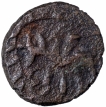This Lot is closed.
- P-Auction # 29
- Bids: 0
- Views:1047
| Start Price 40000 | Estimated Price 40000-45000 |
| login, to view Hammer value | |
| Quick Description | ||||
|---|---|---|---|---|
| Denomination | Copper Unit | Metal | Copper | |
| Full Description: Tribal - Post Mauryan North India, Rajanyas Janapada (100 BC), Copper Fractional Unit, Obv: goddess Lakshmi in standing posture, holding lotus in right hand, Brahmi legend around “(Ra)jana (Ja)napadasa”, Rev: humped Bull (Nandi) walking to left, rayed circle border, 1.37g, 12.07mm, (Handa # Variant of Pl.XXX-12), about very fine, Exceedingly Rare. Note: Rajanyas were amongst the most prominent tribes in ancient India. The word ‘Rajanya’ gets first mention in Purusha Sukta of Rigveda. In Sabhaparva (Mahabharata), they have been mentioned with other contemporary tribes i.e. Sibis, Trigartas, Yaudheyas, Madras and Kekayas. They are said to have been vanquished by Yudhishthira along with the Yaudheyas, Arattas and Madrakas. Panini also refers to the people named ‘Rajanyas’ in his Ganapatha. They are also prominently mentioned in later works like Mahabhashya, Chandravyakarana, Kasika and Sarasvatikanthabharana. Classical writers seem to have referred to them as Xathroi (Chatriaioi by Ptolemy). According to K.K. Dasgupta, Rajanyas lived in eastern Punjab and in eastern Rajasthan. Originally they may have belonged to the Punjab whence from, they probably migrated and settled in eastern parts of Rajasthan. Use of Kharoshthi on their coins indicate a Punjab connection of this tribe. The area and period of circulation of the coins of this tribe seems to be pretty restricted in nature. Around thirty pieces are known, most of which are in museums (16 in BM, 7 in IM and 3 in ANS). The coins are die-struck and known in a singular type (standing figure / bull) and two classes (on the basis of use of Brahmi and Kharoshthi scripts). | ||||


